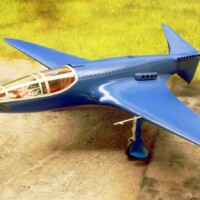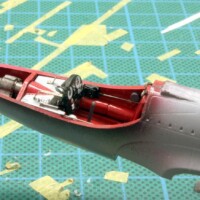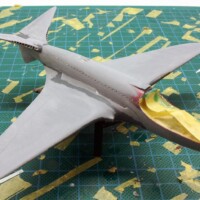The blue dream flies on! Bugatti 100P, a racing aircraft of the 1930s.
Many articles on aircraft models begin with the statement that the original of the presented model is particularly unique. As appropriate as this may be, the Bugatti 100P shown here opens up yet another category of uniqueness all its own!
For example, it is the only aircraft commissioned by Ettore Bugatti, legendary designer of fast cars. In the twenties and thirties, flying, like driving a car, still had the aura of being exclusive, expensive and also dangerous. The intoxication of speed, the penchant for records and the fascination of competition fuelled the activities of designers and daring pilots alike, who were committed to the risky game of constantly testing new limits. So the limits of flying and driving were not yet that far apart.
For both disciplines, the twenties and thirties were the time of great competitions and racing battles. This still peaceful struggle not only drove the development of engines and vehicles, but also provided the stage for the great names of the racing drivers and pilots involved, some of them quite idiosyncratic personalities. In the course of the thirties, the competitions became more and more a show fight of nations. With the catastrophe of autumn 1939, the war gained complete sovereignty over technical development and the race for top performance; circumstances that would also cruelly thin the ranks of the former racing pilots.
It was against this background that the development of the Bugatti 100 took its course. For the participation in the "Coupe Deutsch de la Meurthe" of the year 1938, two years before, in the spring of 1936, the conception of a racing aircraft was started, which would have been an outstanding winner with its unique performances. Ettore Bugatti handed over the reins to the Belgian Louis de Monge, a proven aircraft designer and engineer. Bugatti obviously trusted him to be able to implement his radical ideas - and they were really something!
The new design was to offer unheard-of performance: with a wingspan of 8.2m and a length of 7.7m, the "Type 100P" would be powered by two Bugatti P50 in-line engines mounted in tandem and producing 450hp. On the aircraft, this unconventional engine arrangement is evident from the staggered exhausts on the right and left fuselage sides. Another indication of the two engines are the two counter-rotating propellers: they are each driven by a Bugatti P50.
In combination with an uncompromisingly slim fuselage and the cabin glazing blended into its contour, a speed of over 800 Km/h should be achieved with this drive.
Peculiarities that determine the appearance of the fast racing aircraft can be traced back to Bugatti himself: both the Y-shaped tailplane design and a special composite construction method used to realise the organic-looking forms of the Bugatti 100P can be traced back to patents by Ettore Bugatti.
Work on the ambitious design could not be completed in time for the intended participation in the "Coupe Deutsch de la Meurthe" of 1938. Even at the outbreak of the war, work on the Bugatti 100, which was taking place in France, was not finished. Contemporary pictures show the racy design largely completed, but the surfaces remained unpainted, clearly revealing the wood materials from which the racing plane had been primarily made.
At the beginning of the war, the aircraft, which was in Paris, as well as its design documents, were hidden to prevent them from falling into the hands of the Germans. In fact, the Bugatti 100 was successfully kept out of German hands throughout the war years. It is difficult to say how far Bugatti's plans to develop the racing aircraft into a fighter had progressed by this time. In 1939, the French government verifiably approached Bugatti to have the record-breaking aircraft developed into a military aircraft.
Amazingly, the original of the only aircraft built has survived to this day: the original of the unique Bugatti 100P can be admired in the museum of the EAA, the Experimental Aircraft Association in Oskosh, Wisconsin.
Bugatti's racing plane still inspires and moves people today. A replica of the Bugatti 100P completed in the USA by a private group of enthusiasts took off for its first short flight in 2015. On its third take-off, however, the aircraft tragically crashed from a low altitude and caught fire after impact. The pilot and project initiator Scotty Wilson died in the dramatic accident.
About the kit and building process
Special Hobby has thankfully launched a well-equipped kit of this fast and elegant aircraft in 2022. However, in view of the decidedly "short run" character of the parts, some time must be allowed for trimming, fitting tests and spackling work. Otherwise the kit impresses with an almost perfect fit. This is particularly pleasant when fitting the large cockpit glazing: the difference in size between a large transparent part and the corresponding polysterol parts, which is known from other kits, does not occur here! You can confidently wait until the end of construction to attach the cockpit - there is no need for sanding or adjusting, the fit is perfect.
However, the transition of the wings to the fuselage has to be filled, this is quite heavy and requires several passes. This part has to be done all the more carefully as the model shows a completely continuous transition here.
Thin sanding of the trailing edges of the wings also worked very well. I did this on the wings as well as on the three tail surfaces.
In some details the moulds remain a bit too general. For example, the cockpit interior was re-detailed, here especially the wiring of the instruments is essential. The instrument panel is free standing, so its rear side is easily visible. Brake cables were also added to the landing gear and a Pitot tube made of needle cannulas was added.
In the execution of these parts I was inspired by the appearance of the replica, even though my model is supposed to show the original machine from 1938. So in this respect the model is a bit of a "what if" representation.
Finally, my praise goes to Special Hobby for their highly interesting but probably also courageous choice of models; so at this point an appreciative and anticipatory "Keep up the good work!"
























Great article and model, Roland, Bugattis are really special, I remember someone describing the exhaust sound of a Bugatti 35 racing car as “ripping silk”. Unique is an often mis-used in the English language. Unique shouldn’t be qualified, something is either unique, like this aircraft, or it isn’t. As human beings we are all unique, there is no-one else exactly the same, which helps to make life interesting. Really liked your post as usual, it’s unique.
Sleek now seems too mild of an adjective to describe this beauty Roland. Wow, what a streamlined masterpiece you've chosen and built! I believe your model is only the second one I've seen of this historic and incredible aircraft. Thanks for your article and for building the Bugatti, Roland @rosachsenhofer! That is just some fine scale modeling!
Wow, what a streamlined masterpiece you've chosen and built! I believe your model is only the second one I've seen of this historic and incredible aircraft. Thanks for your article and for building the Bugatti, Roland @rosachsenhofer! That is just some fine scale modeling! 
This aircraft even looks good inverted (pic 17). Just a beautiful machine and such an interesting story about WWII and a sad story about Scott Wilson. Thank you for taking the time to build this and show it.
Never new Bugatti was in aircraft as well, Roland @rosachsenhofer
They did an amazing job in developing this uniquely sleek shaped aircraft.
Thanks for sharing this interesting about it.
Nice work, Roland. Beautiful finish. This is another kit that may become another exception to my stash reduction goal!
Wow - put Buck Rogers in the cockpit and it's ready to go! That is really an amazing aircraft, and a great-looking model.
Nice work and great finish. Bugatti was ahead of his time!
Another amazing subject chosen and a spectacular result, Roland!
Loved reading all these nice details regarding this one-off plane.
Congratulations!
Wonderful representation of such a sleek and striking aircraft! The lines are terrific, but I love the mechanical yet supple look in through the windscreen just as much. Great work as always!
Beautiful work to an amazing looking aircraft.
Hello to all of you! Thank you for this extremely motivating and of course most welcome feedback on the Bugatti! I am pleased that the model is so well received by you.